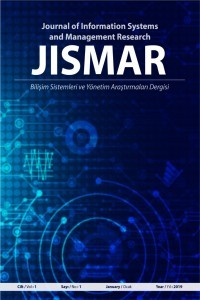Makine Öğrenmesinde Yeni Bir Bakış Açısı: Otomatik Makine Öğrenmesi (AutoML)
AUTOML, Makine Öğrenmesi, Veri
___
- [1] Accenture, “The Team Solution to the Data Scientist Shortage”, Accenture, 2013.
- [2] J. G. Harris and R. Eitel-Porter, “Data scientists: 'As rare as unicorns” https://www.theguardian.com/media-network/2015/feb/12/data-scientists-as-rare-as-unicorns, 2015.
- [3] insideBIGDATA, “The Data Scientist Shortage is Huge” Here’s How to Beat It, https://insidebigdata.com/2018/12/27/data-scientist-shortage-huge-heres-beat/ , 2018.
- [4] A. Woodle, What’s Driving Data Science Hiring in 2019. https://www.datanami.com/2019/01/30/whats-driving-data-science-hiring-in-2019/ , 2019.
- [5] J. R. Lloyd, D. K. Duvenaud, R. B. Grosse, J. B. Tenenbaum, Z. Ghahramani, “Automatic construction and natural-language description of nonparametric regression models”. In Proceedings of the Twenty- Eighth AAAI Conference on Artificial Intelligence, 2014.
- [6] M. Feurer, A. Klein, K. Eggensperger, J. Springenberg, M. Blum, F. Hutter, “Efficient and robust automated machine learning”. In C. Cortes,N.D. Lawrence, D. D. Lee, M. Sugiyama,&R. Garnett (Eds.), Advances in neural information processing systems, Curran Associates, Inc, 2015, pp. 2962–2970.
- [7] A. Romblay, “Automated Machine Learning” Datahack Summit, Anlytics Vidhya, 2017 [8] Bengio, Y. “Gradient-based optimization of hyperparameters”, Neural computation, 2000, 12 (8), pp. 1889-1900.
- [9] J. Bergstra, Y. Bengio, Y. (2012). “Random search for hyper-parameter optimization”, Journal of Machine Learning Research, 2012, 13(Feb), pp.281-305.
- [10] R. Kohavi ve G. John, “Automatic Parameter Selection by Minimizing Estimated Error” In: Prieditis, A., Russell, S. (eds.) Proceedings of the Twelfth International Conference on Machine Learning, Morgan Kaufmann Publishers. 1995, pp. 304–312.
- [11] H. Escalante, M. Montes, E. Sucar, “Particle Swarm Model Selection”. Journal of Machine Learning Research, 2009, 10, pp. 405–440.
- [12] C. Thornton, F. Hutter, H. Hoos, K. Leyton-Brown, “Auto-WEKA: combined selection and hyperparameter optimization of classification algorithms”. In: Dhillon, I., Koren, Y., Ghani, R., Senator, T., Bradley, P., Parekh, R., He, J., Grossman, R., Uthurusamy, R. (eds.) The 19th ACM SIGKDD International Conference on Knowledge Discovery and Data Mining (KDD’13), ACM Press, 2013, 847–855.
- [13] R. Mantovani, T. Horvath, R. Cerri, J. Vanschoren, A. Carvalho. “Hyper-Parameter Tuning of a Decision Tree Induction Algorithm”. In:5th Brazilian Conference on Intelligent Systems, IEEE Computer Society Press, 2016, 37–42.
- [14] S. Sanders ve C. Giraud-Carrier, “Informing the Use of Hyperparameter Optimization Through Metalearning”. In: Gottumukkala, R., Ning, X., Dong, G., Raghavan, V., Aluru, S., Karypis, G., Miele, L., Wu, X. (eds.) 2017 IEEE International Conference on Big Data (Big Data). IEEE Computer Society Press, 2017.
- [15] R. Olson, W. La Cava, Z. Mustahsan, A. Varik, J. Moore, “Data-driven advice for applying machine learning to bioinformatics problems”. In: Proceedings of the Pacific Symposium in Biocomputing 2018, 192–203.
- [16] L. Kotthoff, C. Thornton, H. Hoos, F. Hutter, K. Leyton-Brown, “Auto-WEKA 2.0: Automatic model selection and hyperparameter optimization in WEKA”. Journal of Machine Learning Research, 2017, 18, 1–5.
- [17] F. Hutter, R. Caruana, R. Bardenet, M. Bilenko, I. Guyon, B. Kegl, H. Larochelle, “AutoML”, ICML Workshop, 2014.
- [18] B. Komer, J. Bergstra, C. Eliasmith, “Hyperopt-sklearn: Automatic hyperparameter configuration for scikit-learn”. In ICML workshop on AutoML, 2014.
- [19] M. Feurer, A. Klein, K. Eggensperger, J. Springenberg, M. Blum, “Efficient and Robust Automated Machine Learning”. Advances in Neural Information Processing Systems 2015, 28, 2962–2970.
- [20] A. Balaji, A. Allen, “Benchmarking Automatic Machine Learning Frameworks”, 2018, arXiv:1808.06492 CoRR abs/1808.06492. URL http://arxiv.org/abs/1808.06492.
- [21] F. Hutter, H. Hoos, K. Leyton-Brown, “Sequential model-based optimization for general algorithm con_guration”. In International Conference on Learning and Intelligent Optimization, Springer , 2011, 507-523.
- [22] K. Swersky, J. Snoek, P. R. Adams, Freeze-thaw bayesian optimization, 2014, arXiv preprint arXiv:1406.3896.
- [23] M. Munoz, L. Villanova, D. Baatar, K. Smith-Miles, “Instance spaces for machine learning classification”, Machine Learning, 2018, 107(1), pp.109-147.
- [24] B. Zoph, Q. V. Le, Neural architecture search with reinforcement learning, 2016, arXiv preprint arXiv:1611.01578.
- [25] Y. Lu, “An end-to-end autoML aolution for tabular data at KaggleDays”, Google AI Blog: 2019, May 9, https://ai.googleblog.com/2019/05/an-end-to-end-automl-solution-for.html.
- ISSN: 2717-9931
- Yayın Aralığı: Yılda 2 Sayı
- Başlangıç: 2019
- Yayıncı: M. Hanefi CALP
Smart City Applications In Digital Age: State-Of-Art Review and Critique
Yapay Zeka ile Siber Zorbalık Eğiliminin Belirlenmesi
Makine Öğrenmesinde Yeni Bir Bakış Açısı: Otomatik Makine Öğrenmesi (AutoML)
Ders Programı Çizelgeleme Probleminin Genetik Algoritma ile Optimizasyonu
Yapay Zekâ Yöntemlerinde Entropi
Muhammed Ali KOŞAN, Aysun COŞKUN, Hacer KARACAN
Blockchain Tabanlı Bir Veri Yönetim Modeli
Mohammed ALSADİ, Sevinç GÜLSEÇEN, Sinan KARA, Büşra ÖZDENİZCİ KÖSE, Vedat COŞKUN
Yazılım Hata Kestirimine Nesne Yönelimli Ölçütlerin Etkisi
Tülin ERÇELEBİ AYYILDIZ, Begüm ERKAL
Sadakat Programında Müşteri Kayıp Tahmini: Bir Vaka Çalışması
Yeşim KOCA, Burak Emre SÖĞÜT, Sona MARDİKYAN
Yeni Dünya Düzeninde Öğrenen Örgütler, Değişim ve İnovasyon Yönetimi
